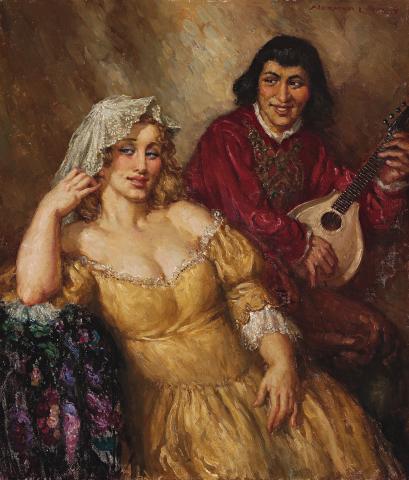LADY AND TROUBADOUR, c.1937
NORMAN LINDSAY
oil on canvas
75.0 x 64.0 cm
signed upper right: NORMAN LINDSAY
Academy Arts, Sydney
Roy and Nancy Melick, Sydney
Estate of Nancy Melick OAM, Sydney
Bloomfield, L., Norman Lindsay: Oil Paintings 1889 – 1969, Odana Editions, Bungendore, New South Wales, 2006, illus. in background of interior image, Springwood, c. 1968, p. 216
Lady and Troubadour, c.1937 appears on display in the background of a photograph of Norman Lindsay with his model, Rita Lee at the artist’s residence, Springwood, c. 1968.
A romantic courting subject, set in medieval times with serenading troubadour and lute, Lady and Troubadour was painted around the time Norman Lindsay completed his extraordinary, large and ambitious Don Juan 1935 (The University of Melbourne Art Collection, a gift of the artist, 1969).
Don Juan and portrait of Donna Inez 1935 (Don Juan’s mother) were inspired by Lord Byron’s great epic poem about the Spanish nobleman who seduced and abandoned hundreds of women.
Lindsay described his feeling for the poem in a letter to Keith Wingrove in 1952: ‘Byron and his period have always been for me a major preoccupation for, apart from a personal love for Byron himself and admiration for Don Juan as not only the greatest narrative poem in the English, or any other language, but the most courageous attack on the disgusting prudery which has violated even the best English poets and novelists from that day to this...’.’1
Often finding inspiration from literature, in Lady and Troubadour Lindsay draws upon a more Shakespearean expression of love and harmony. Although our Lady would seem more suited to Falstaff’s company than Romeo’s, the underlying metaphor is consistent and Lindsay’s visual innuendos are clear: As the figures echo each other’s pose, the colour of their clothes and hair harmonising whilst their sideways looks imply some activity out of our view, our eye follows the forms of the figures like the figure-eight pattern of an orchestra conductor’s baton. Love, lust, rhythm and harmony combine within the flirtatious and suggestive Lady and Troubadour.
1. Bloomfield, L., Norman Lindsay Oil Paintings 1889-1969, Odana Editions, Bungendore, New South Wales, 2006, p. 88
